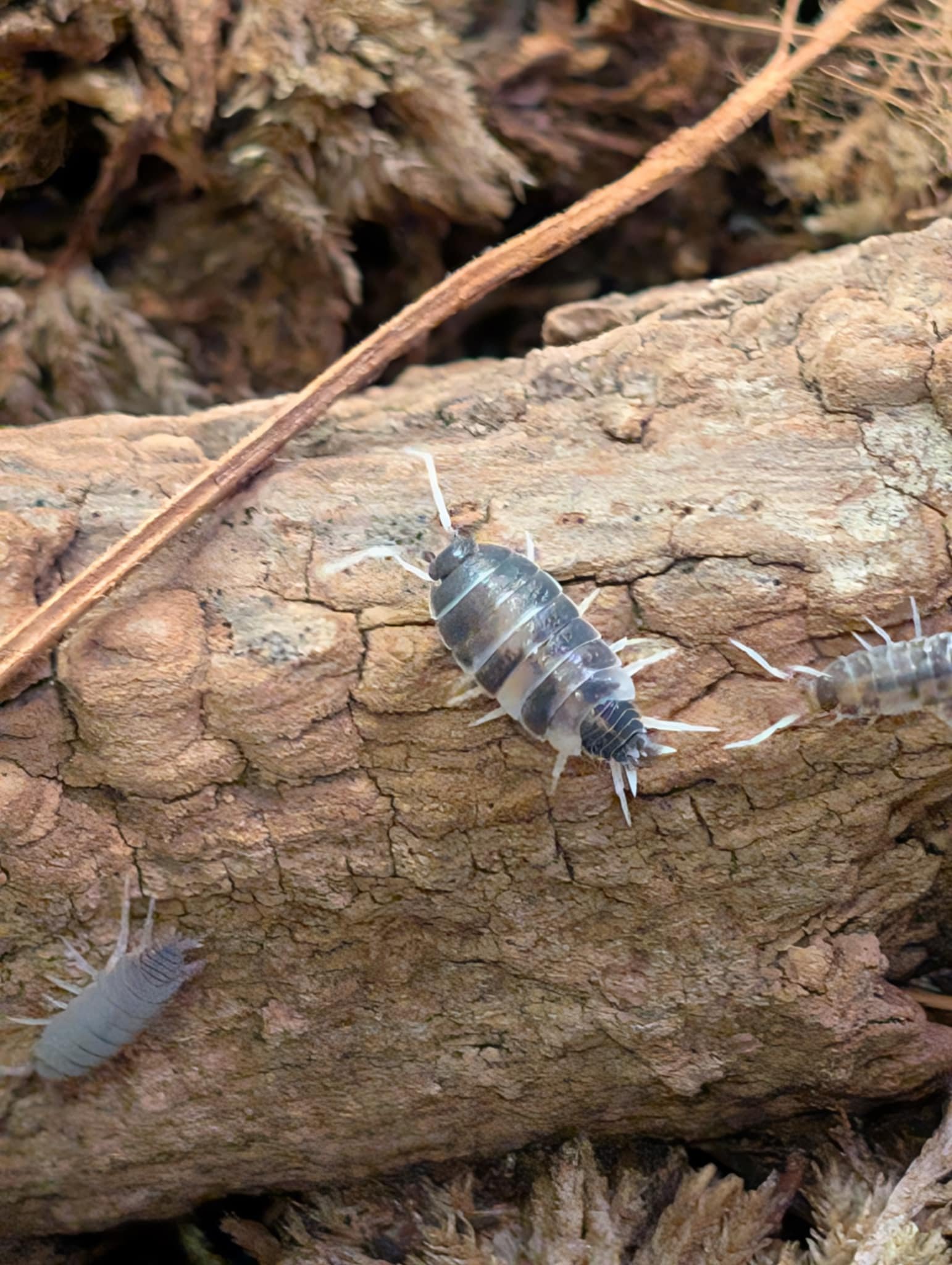
Oreo Crumble
20 Count per Culture
The Oreo Crumble Isopod, scientifically known as Porcellionides pruinosus "Oreo Crumble", is a delightful variety of isopod that's gained popularity for its striking appearance and ease of care. Here's a breakdown of what makes them so special:
Appearance:
Size: They are a small to medium-sized isopod, reaching about 1 centimeter (0.4 inches) in length.
Coloration: Their defining feature is their black and white coloration, reminiscent of an Oreo cookie.The black base color is contrasted with bright white or cream-colored spots and markings, creating a visually appealing pattern.
Shape: They have an oval-shaped, segmented body, typical of Porcellionides isopods.
Habitat and Care:
Origin:Porcellionides pruinosus is a widespread species, and the "Oreo Crumble" variety is a selectively bred morph.
Environment: They thrive in warm, humid environments with good ventilation.
Temperature: They prefer temperatures between 70-85°F (21-29°C).
Humidity: High humidity is essential for their well-being, ideally around 60-80%.
Substrate: A mix of damp soil, leaf litter, decaying wood, and sphagnum moss provides an ideal substrate.
Enclosure: A well-ventilated container with plenty of hiding places (cork bark, leaf litter, etc.) is necessary.
Other Characteristics:
Temperament: They are generally peaceful and easy to handle, though they prefer to stay hidden.
Breeding: They breed readily in captivity, with females carrying the eggs in a brood pouch until they hatch.
Lifespan: They can live for several years with proper care.
Bioactive Clean-up Crew:They are a popular choice for bioactive terrariums, where they help break down organic waste and contribute to a healthy ecosystem.
Important Notes:
Humidity: Maintaining proper humidity is crucial for their health. Insufficient humidity can lead to molting problems and even death.
Ventilation: While they need high humidity, they also require good ventilation to prevent the growth of mold and mildew.
Diet:They are detritivores, feeding on decaying organic matter, leaf litter, and wood. They also benefit from supplemental feeding with fruits, vegetables, and protein sources like fish flakes or dried shrimp
20 Count per Culture
The Oreo Crumble Isopod, scientifically known as Porcellionides pruinosus "Oreo Crumble", is a delightful variety of isopod that's gained popularity for its striking appearance and ease of care. Here's a breakdown of what makes them so special:
Appearance:
Size: They are a small to medium-sized isopod, reaching about 1 centimeter (0.4 inches) in length.
Coloration: Their defining feature is their black and white coloration, reminiscent of an Oreo cookie.The black base color is contrasted with bright white or cream-colored spots and markings, creating a visually appealing pattern.
Shape: They have an oval-shaped, segmented body, typical of Porcellionides isopods.
Habitat and Care:
Origin:Porcellionides pruinosus is a widespread species, and the "Oreo Crumble" variety is a selectively bred morph.
Environment: They thrive in warm, humid environments with good ventilation.
Temperature: They prefer temperatures between 70-85°F (21-29°C).
Humidity: High humidity is essential for their well-being, ideally around 60-80%.
Substrate: A mix of damp soil, leaf litter, decaying wood, and sphagnum moss provides an ideal substrate.
Enclosure: A well-ventilated container with plenty of hiding places (cork bark, leaf litter, etc.) is necessary.
Other Characteristics:
Temperament: They are generally peaceful and easy to handle, though they prefer to stay hidden.
Breeding: They breed readily in captivity, with females carrying the eggs in a brood pouch until they hatch.
Lifespan: They can live for several years with proper care.
Bioactive Clean-up Crew:They are a popular choice for bioactive terrariums, where they help break down organic waste and contribute to a healthy ecosystem.
Important Notes:
Humidity: Maintaining proper humidity is crucial for their health. Insufficient humidity can lead to molting problems and even death.
Ventilation: While they need high humidity, they also require good ventilation to prevent the growth of mold and mildew.
Diet:They are detritivores, feeding on decaying organic matter, leaf litter, and wood. They also benefit from supplemental feeding with fruits, vegetables, and protein sources like fish flakes or dried shrimp
